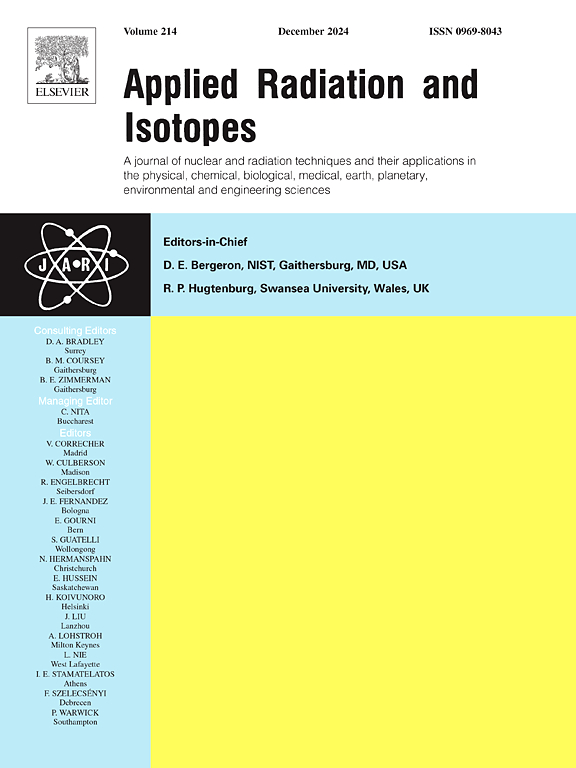The production and separation of 161Tb with high specific activity at the University of Utah
IF 1.6
3区 工程技术
Q3 CHEMISTRY, INORGANIC & NUCLEAR
引用次数: 0
Abstract
Targeted radiotherapy (TRT) is an increasingly prominent area of research in nuclear medicine, particularly in the context of treating cancerous tumors. One radionuclide of considerable interest for TRT is terbium-161 (t1/2 = 6.95 days), which undergoes beta emission and shares similar decay properties as 177Lu (FDA-approved as LUTATHERA® and PLUVICTO®). Besides beta emission, 161Tb also emits a significant number of conversion and Auger electrons further enhancing its therapeutic potential. Terbium-161 can be produced using nuclear reactors through an indirect neutron capture reaction, , from 160Gd targets. However, a key challenge in utilizing 161Tb for TRT lies in effectively separating target and product materials to attain high specific activity for radiolabeling. Here, we detail the production of no-carrier added 161Tb using low flux research reactors (mean thermal (<0.625 eV) neutron flux: ) like the University of Utah TRIGA Reactor, using enriched 160Gd2O3 targets (1.5 ± 0.3 μCi of 161Tb per mg of 160Gd target per hour of irradiation). We also developed a separation technique based on cation exchange and extraction chromatography, suitable for mCi level irradiations with targets exceeding 200 mg. In a simulated full-scale irradiation, 161Tb was successfully isolated from large mass targets using cation exchange (AG 50W-X8, with 2-hydroxyisobutyric acid at 70 mM, pH 4.75) and extraction chromatography (LN Resin, 0.5–0.75 M HNO3) methods. This resulted in high apparent molar activities of [161Tb]Tb-DOTA (113 ± 3 MBq/nmol), demonstrating high purity 161Tb relevant for potential future preclinical applications.
犹他大学生产和分离高比活度的 161Tb。
靶向放射治疗(TRT)是核医学中一个日益突出的研究领域,尤其是在治疗癌症肿瘤方面。铽-161(t1/2 = 6.95 天)是一种在 TRT 方面颇受关注的放射性核素,它会发生β发射,并具有与 177Lu(FDA 批准的 LUTATHERA® 和 PLUVICTO®)类似的衰变特性。除β发射外,161Tb还发射大量转换电子和奥杰电子,进一步提高了其治疗潜力。铽-161 可以通过核反应堆从 160Gd 靶件中通过间接中子俘获反应 G64160dn,γG64161d→3.66min,β-T65161b 生产出来。然而,将 161Tb 用于 TRT 的一个关键挑战在于如何有效分离靶和产物材料,以获得高特异性放射性标记活性。在此,我们详细介绍了利用犹他大学 TRIGA 反应器等低通量研究反应器(平均热(12n∙cm-2∙s-1)),使用富集 160Gd2O3 靶件(每小时辐照每毫克 160Gd 靶件可产生 1.5 ± 0.3 μCi 161Tb)生产无载体添加 161Tb的情况。我们还开发了一种基于阳离子交换和萃取色谱法的分离技术,适用于 mCi 级辐照,靶件超过 200 毫克。在模拟的全规模辐照中,使用阳离子交换(AG 50W-X8,2-羟基异丁酸 70 mM,pH 4.75)和萃取色谱(LN 树脂,0.5-0.75 M HNO3)方法,成功地从大质量目标中分离出了 161Tb。这使得[161Tb]Tb-DOTA 的表观摩尔活性很高(113 ± 3 MBq/nmol),证明了 161Tb 的高纯度与未来潜在的临床前应用相关。
本文章由计算机程序翻译,如有差异,请以英文原文为准。
求助全文
约1分钟内获得全文
求助全文
来源期刊

Applied Radiation and Isotopes
工程技术-核科学技术
CiteScore
3.00
自引率
12.50%
发文量
406
审稿时长
13.5 months
期刊介绍:
Applied Radiation and Isotopes provides a high quality medium for the publication of substantial, original and scientific and technological papers on the development and peaceful application of nuclear, radiation and radionuclide techniques in chemistry, physics, biochemistry, biology, medicine, security, engineering and in the earth, planetary and environmental sciences, all including dosimetry. Nuclear techniques are defined in the broadest sense and both experimental and theoretical papers are welcome. They include the development and use of α- and β-particles, X-rays and γ-rays, neutrons and other nuclear particles and radiations from all sources, including radionuclides, synchrotron sources, cyclotrons and reactors and from the natural environment.
The journal aims to publish papers with significance to an international audience, containing substantial novelty and scientific impact. The Editors reserve the rights to reject, with or without external review, papers that do not meet these criteria.
Papers dealing with radiation processing, i.e., where radiation is used to bring about a biological, chemical or physical change in a material, should be directed to our sister journal Radiation Physics and Chemistry.
 求助内容:
求助内容: 应助结果提醒方式:
应助结果提醒方式:


